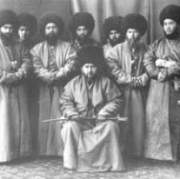
"That the Khan of Khiva can dispose despotically, according to his good pleasure, of the property and lives of his subjects, scarcely requires to be mentioned."
Arminius Vambery 'Travels in Central Asia' 1864
 'The Retinue of Feruz Khan' taken from 'Khiva Caught in Time' |
The Khans were the autocratic rulers of Khiva and built up a reputation abroad for their dictatorial style of leadership. However, they were also subject to certain laws. The Khiva constitution, of Mongol origin, required the Khan to appoint four Inaq (literally 'younger brother'), two of whom should be close relatives and two merely of the same race. The Khan had to be a descendent of Genghis Khan, and his political powers were balanced by the religious ones held by his spiritual Nakhib, a 'Said' and one of Mohammed's descendants. Coronation took place under a large piece of white felt. The Khan would remain on the throne until death, at which point the throne should, in theory, be passed on to his eldest son.
 Taken from 'Khiva Caught in Time' |
The perks of Khanship included unlimited power, lavish lifestyles and an overflowing harem. However, Khanship usually also entailed regular battles against the wild Turkomans and treacherous Bukharans, constant fear of assassination by rival brothers and the complicity of his grovelling courtiers. The Khan's wily aides showed fear and trembling to his face, but were quick to feather their own nests when his back was turned. As Vambery wryly noted concerning the taxes due to the Khan, 'The Khan last year was made to believe that the Karakalpak had only 6,000 oxen, and the Yomuts and Techauders only 3,000 sheep taxed last year, which was, as I heard, only a third of the truth.'
The last Khans to rule Khiva and its regions were the Kungrad Dynasty,
named after the town of their founder. After the invasion of the Persian
Shah Nodir, there were a series of revolts which culminated in the overthrow
of the Persian forces and left a vacuum of leadership. Quick to jump to
the throne in Khiva were the Kazakh tribal chiefs, who ruled for 60 years.
However, an Uzbek chieftain from Kungrad was to leave an indelible print
on the fortunes of the Khanate for the next two hundred years...